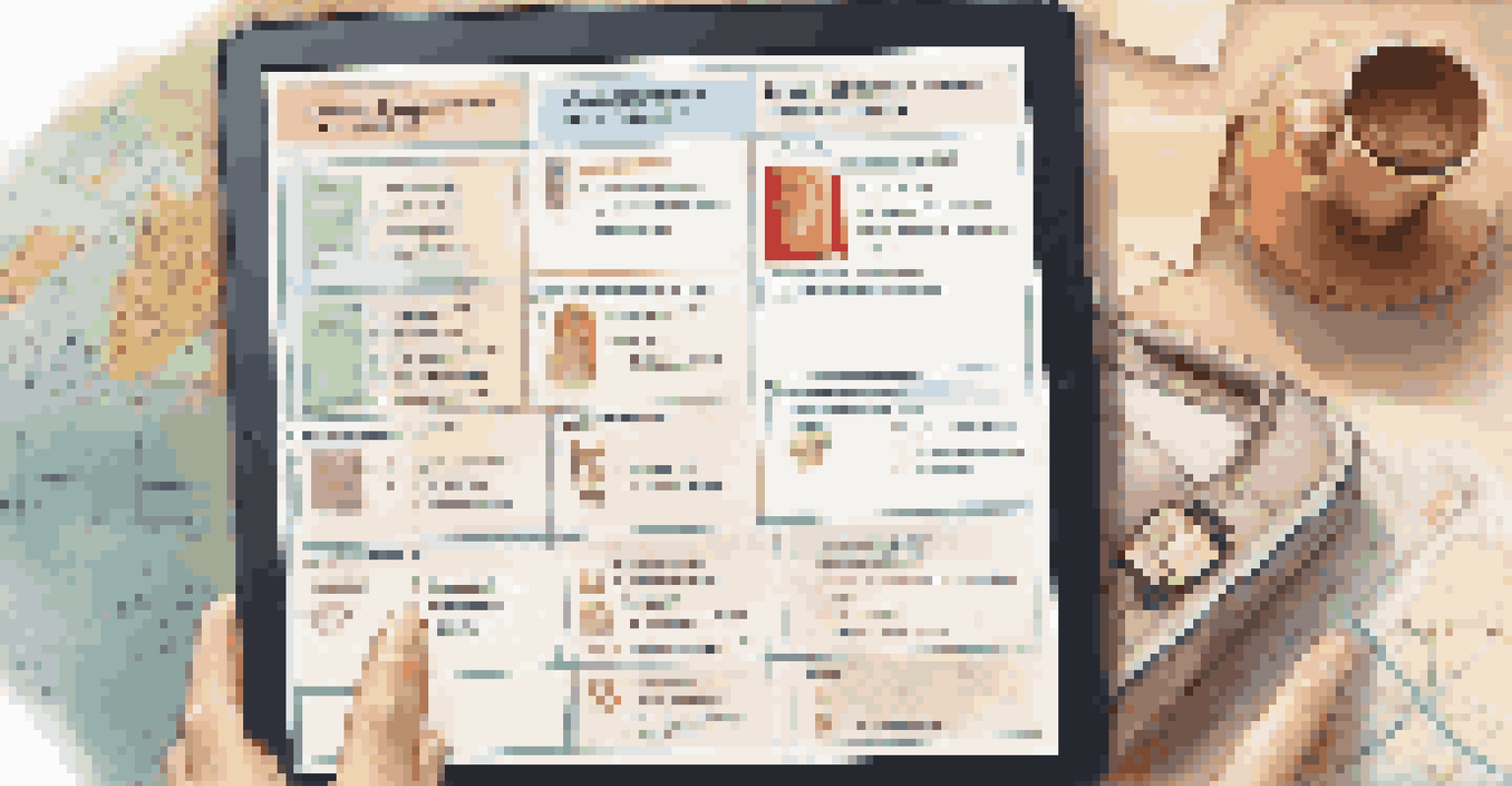How to Organize Travel Documents with Digital Tools

Understanding the Importance of Organized Travel Documents
When it comes to traveling, having your documents in order can make or break your trip. Imagine standing in line at the airport, fumbling through papers while others breeze by—stressful, right? Organized documents not only save time but also provide peace of mind, allowing you to focus on enjoying your journey.
The journey of a thousand miles begins with one step.
With the right digital tools, you can streamline this process and avoid those frantic searches for essentials like your passport or itinerary. Think of it as creating your travel toolkit, where everything you need is just a click away. This preparation paves the way for a smoother travel experience, letting you savor every moment.
In today’s tech-savvy world, there’s no need to rely solely on physical copies of your travel documents. Embracing digital solutions can enhance your efficiency and keep your information secure, ensuring that you’re always ready for wherever your adventure takes you.
Choosing the Right Digital Tools for Document Management
With so many digital tools available, choosing the right ones can feel overwhelming. Start by identifying your needs—do you require a simple storage solution, or do you want an all-in-one travel planner? Popular options include cloud storage services like Google Drive or Dropbox, which allow you to access documents from any device.

Additionally, consider travel-specific apps such as TripIt or Kayak that help organize your itineraries and confirmations. These tools automatically pull information from your email, creating a seamless travel experience. It’s like having a personal assistant at your fingertips, guiding you through your journey.
Organize Travel Documents Effectively
Keeping your travel documents organized can save time and reduce stress during your journey.
Ultimately, the right tool should fit your lifestyle and travel habits. Test out a few options to see which ones resonate with you, keeping in mind that the goal is to simplify your travel experience and keep everything in one place.
Scanning and Digitizing Physical Travel Documents
If you have a stash of physical documents, the first step is to digitize them. Scanning your passports, tickets, and hotel confirmations ensures you have backups just in case. There are numerous apps available, like CamScanner or Adobe Scan, that make this process quick and easy, turning your smartphone into a portable scanner.
By failing to prepare, you are preparing to fail.
Once digitized, save these files in a well-organized folder on your device or cloud storage. You can label them with clear titles, such as 'Passport' or 'Flight Details,' making retrieval a breeze. This method not only declutters your travel space but also provides peace of mind.
Remember, it’s vital to keep these digital copies secure. Use strong passwords and consider enabling two-factor authentication to safeguard your sensitive information. This way, you can travel confidently, knowing your important documents are protected.
Creating a Travel Document Checklist for Easy Access
A travel document checklist is a game-changer for ensuring you don’t forget anything essential. Start by listing all the documents you'll need for your trip, such as your passport, visa, and travel insurance. This checklist acts as your roadmap, guiding you through the packing and preparation process.
You can create this checklist digitally using tools like Google Docs or Excel, allowing for easy edits and updates. As you gather each document, you can check them off, providing a sense of accomplishment. Plus, having everything in one document means you won't have to scramble last minute.
Leverage Digital Tools for Ease
Utilizing mobile apps and cloud services can streamline document management, making important files easily accessible.
Consider sharing your checklist with travel companions, so everyone is on the same page. This collaborative effort can prevent any last-minute surprises and ensure a smoother travel experience for everyone involved.
Utilizing Mobile Apps for Document Storage and Access
Mobile apps are your best friends when it comes to storing and accessing travel documents on the go. Apps like Evernote or Microsoft OneNote allow you to keep important files at your fingertips, accessible anytime and anywhere. This convenience is especially handy during airport check-ins or hotel registrations.
Moreover, these apps often have features that enable you to scan documents directly into them, further simplifying the organization process. Imagine arriving at your destination and being able to pull up your hotel reservation with just a few taps—it's that simple!
Additionally, many of these apps allow you to categorize your documents, making it easy to find what you need when you need it. By leveraging mobile technology, you can ensure that your travel documents are always organized and within reach.
Sharing Travel Documents Securely with Family and Friends
Traveling with family or friends often means sharing important documents, and doing so securely is crucial. Consider using cloud storage services that offer sharing options, allowing you to grant access to specific documents without compromising your entire folder. This way, everyone has what they need without the hassle of physical copies.
Another option is to use encrypted messaging apps like Signal or WhatsApp to send documents securely. These platforms prioritize privacy, ensuring that your sensitive information remains protected. Just remember to remind your travel companions to delete the files after use to maintain security.
Securely Share and Backup Documents
Sharing documents securely and regularly backing them up ensures that you have access to vital information throughout your travels.
Sharing documents digitally not only reduces the risk of loss but also enables quick updates. If there’s a change in itinerary or accommodations, you can easily notify everyone involved in real-time, keeping everyone informed and reducing travel stress.
Backing Up Your Digital Travel Documents for Peace of Mind
Backing up your travel documents is a step that shouldn't be overlooked. Just like you wouldn't leave your house without checking for your keys, ensure your digital documents are secure. Use multiple cloud services or external hard drives to create backups of your travel files.
This way, if one service goes down or you lose access to your device, you still have a safety net. It’s always better to be over-prepared than to face a situation where your important documents are inaccessible. Think of it as having a spare tire in your trunk—you hope you never need it, but you’re glad it’s there.

Regularly updating your backups is equally important. Set a reminder to do this before each trip, ensuring all your latest documents are safely stored. With your backups in place, you can embark on your journey with complete peace of mind.
Final Tips for a Smooth Travel Document Organization
As you prepare for your next adventure, keep these final tips in mind for organizing your travel documents. First, always check expiration dates on your passport and any necessary visas well in advance. This proactive approach will prevent any last-minute surprises that could derail your trip.
Next, maintain a consistent organization system across all your devices. Whether you prefer folders, tags, or color coding, having a standardized method makes it easier to retrieve documents quickly. You want your travel experience to be enjoyable, not a scavenger hunt for papers.
Lastly, stay flexible. Sometimes plans change, and new documents may be required. By keeping your digital tools updated and regularly reviewing your organization methods, you can adapt easily to any travel hiccups that come your way.